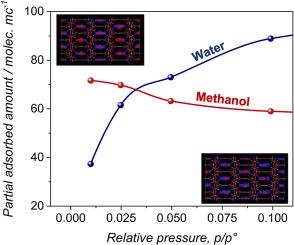Selectivity control in the sorption of humid methanol over the porous metal organic framework MIL-120(Al)
IF 4.7
3区 材料科学
Q1 CHEMISTRY, APPLIED
引用次数: 0
Abstract
This study examines the adsorption properties of MIL-120(Al) for pure vapour-phase sorbates (water and methanol) and their mixtures, with a particular focus on the material's selectivity influenced by relative pressure. The selected MOF presents 1-D channels of ∼3.5 × 6 Å2 aperture, associated with a specific surface area of 350 m2/g and a pore volume of 0.26 cm3/g. Adsorption isotherms at 25 °C, supported by Grand Canonical Monte Carlo (GCMC) simulations, revealed a high affinity of MIL-120(Al) for water and methanol at relative pressures lower than 0.2. However, methanol was identified as the preferred adsorbate at these low relative pressures in water-methanol mixtures. This selectivity, confirmed by GCMC, showed that the composition of the adsorbed phase was made of 90 % of methanol, regardless of the equilibrium vapour phase composition. In contrast, at higher relative pressures, the selectivity of MIL-120(Al) shifted markedly towards water, thereby highlighting the sensitivity of MIL-120(Al) to relative pressure in competitive adsorption scenarios. At high relative pressure, the composition of the adsorbed phase was found to be more than 95 % molar of water, even for vapours mixtures made of 50 % methanol. These findings contribute valuable insights into the design of pressure-sensitive adsorption systems for industrial applications such as sorption enhanced reaction production (SERP) technology.

多孔金属有机骨架MIL-120(Al)吸附湿甲醇的选择性控制
本研究考察了MIL-120(Al)对纯气相山梨酸酯(水和甲醇)及其混合物的吸附特性,特别关注了材料的选择性受相对压力的影响。所选择的MOF具有孔径为~ 3.5 × 6 Å2的一维通道,比表面积为350 m2/g,孔体积为0.26 cm3/g。25°C时的吸附等温线,由大规范蒙特卡罗(GCMC)模拟支持,表明MIL-120(Al)在相对压力低于0.2时对水和甲醇具有高亲和力。然而,在水-甲醇混合物中,甲醇被确定为在这些低相对压力下的首选吸附质。GCMC证实了这种选择性,表明无论平衡气相组成如何,吸附相的组成均由90%的甲醇组成。相比之下,在较高的相对压力下,MIL-120(Al)的选择性明显转向水,从而突出了MIL-120(Al)在竞争吸附情况下对相对压力的敏感性。在较高的相对压力下,发现吸附相的组成超过95%摩尔的水,即使是由50%甲醇制成的蒸汽混合物。这些发现为工业应用的压敏吸附系统的设计提供了有价值的见解,例如吸附增强反应生产(SERP)技术。
本文章由计算机程序翻译,如有差异,请以英文原文为准。
求助全文
约1分钟内获得全文
求助全文
来源期刊

Microporous and Mesoporous Materials
化学-材料科学:综合
CiteScore
10.70
自引率
5.80%
发文量
649
审稿时长
26 days
期刊介绍:
Microporous and Mesoporous Materials covers novel and significant aspects of porous solids classified as either microporous (pore size up to 2 nm) or mesoporous (pore size 2 to 50 nm). The porosity should have a specific impact on the material properties or application. Typical examples are zeolites and zeolite-like materials, pillared materials, clathrasils and clathrates, carbon molecular sieves, ordered mesoporous materials, organic/inorganic porous hybrid materials, or porous metal oxides. Both natural and synthetic porous materials are within the scope of the journal.
Topics which are particularly of interest include:
All aspects of natural microporous and mesoporous solids
The synthesis of crystalline or amorphous porous materials
The physico-chemical characterization of microporous and mesoporous solids, especially spectroscopic and microscopic
The modification of microporous and mesoporous solids, for example by ion exchange or solid-state reactions
All topics related to diffusion of mobile species in the pores of microporous and mesoporous materials
Adsorption (and other separation techniques) using microporous or mesoporous adsorbents
Catalysis by microporous and mesoporous materials
Host/guest interactions
Theoretical chemistry and modelling of host/guest interactions
All topics related to the application of microporous and mesoporous materials in industrial catalysis, separation technology, environmental protection, electrochemistry, membranes, sensors, optical devices, etc.
 求助内容:
求助内容: 应助结果提醒方式:
应助结果提醒方式:


